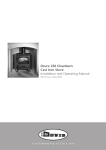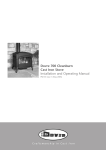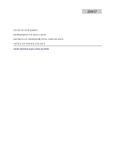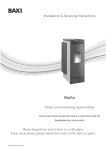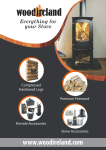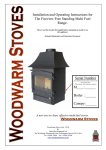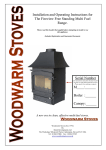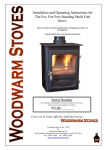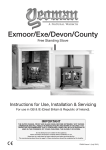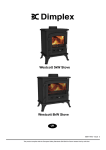Download Dovre 425MF Manual.qxd
Transcript
Dovre 425 Multi-fuel Cast Iron Stove Installation and Operating Manual PM152 Issue 1 (May 2005) Craftsmanship in Cast Iron Dovre 425 Multi-fuel Cast Iron Stove Installation and Operating Manual These instructions should be read carefully and saved by the user for future reference. Contents Introduction to you new Dovre 4255: Introduction to your Dovre Stove 2 We would like to thank you for purchasing a Dovre stove and trust that it will provide you with many years of useful service. Unpacking your Dovre 425 3 Getting the best from your Dovre 425 3 Location for the installation 4 Assembly 3-4 Installation 4 Chimney Connections 4-5 Operating your Dovre 425 5-7 Servicing and Maintenance 7 Warranty Details 7 Guide to Woodburning 8 Troubleshooting 8 At Dovre we have been producing cast iron stoves for over 60 years and we strive to ensure that our products meet with the highest level of performance, efficiency, safety and quality. So much so that we guarantee all Dovre body castings for 5 years. Owning a stove might be a new experience for you. Therefore, to ensure that you get the best performance from your new Dovre, do please take a little time to read through this manual. The 425MFR is a specially designed stove for burning wood and a variety of smokeless fuels. It is essential that when wood is used, it is well seasoned for a minimum of 2 years and has maximum moisture content of 20%. If unseasoned wood is used, maximum heat outputs will not be obtained and serious damage will occur in the chimney and flue ways. The dimensions of your new stove are illustrated in Fig.1. Be careful to ensure that your fireplace is going to accept the appliance and that you have allowed for at least 300mm of hearth space in front of the stove. WE RECOMMEND THAT, YOUR DOVRE IS FITTED BY AN EXPERIENCED INSTALLER ACCUSTOMED TO THE INSTALLATION OF SOLID FUEL BURNING APPLIANCES. If you are unsure about any aspect of the installation or operation procedures, your Dovre dealer will be pleased to help. It is important that the installation is carried out in compliance with current Building Regulations. SAFETY A fireguard is not provided with this stove. However, it is recommended that one compliant with BS 6539 or BS 6778 is fitted, particularly if the stove is to be used in the presence of young children, the elderly and infirm. Fig 1-STOVE DIMENSIONS Width Height Depth Weight Heat output Flue diameter 550mm 10mm 445mm 130kg 10kW 50mm 2 Unpacking your Dovre 425 Location for Installation If your Dovre 425 is finished in enamel, care should be taken to avoid knocks as the enamel surface could “chip”. The location in which your stove is to be installed will of course depend on the chimney available. If you do not have a chimney, there are a number of prefabricated flue systems available and your Dovre Dealer will be pleased to offer guidance on the subject. Care should be taken not to break the glass whilst handling the appliance. Your Dovre 425 is constructed from high-grade quality cast iron and is therefore not light in weight. We recommend that 2 people are available to handle the stove. Building Regulations must be observed when considering the location of your Dovre 425. More precise information can be found later in this manual but it is important to ensure that a suitable hearth, complying with Building Regulations, is available. Before taking your Dovre to its installation location, remove the stove from its outer packing and timber pallet. Stand the stove in the upright position, protecting carpets or other floor coverings with rigid cardboard. The stove carton is ideal for this purpose. NEVER ALLOW A MECHANICAL AIR EXTRACTOR TO BE USED IN THE ROOM OR ADJOINING ROOMS AS THIS COULD CAUSE THE APPLIANCE TO EMIT SMOKE INTO THE ROOM. Locate the small green quality control slip and retain for future reference. Assembly RIDDLING GRATE FITTING THE FLUE CONNECTOR Check that the riddling bar, located on the left hand side of the stove, moves easily when pushed in and out and that the circular grate revolves freely. If your Dovre 425 is to be connected to the chimney via the top flue connector, proceed as follows: • Remove the circular blanking plate from the top of the stove using the tool kit provided. Follow instructions enclosed with the tool kit. • Apply a thin and even coat of fire cement to the flange on the flue spigot. 1. USE GOOD FUEL - NEVER BURN UNSEASONED OR DAMP WOOD • Attach the flue spigot to the top opening in the stove, using the 2 nuts and bolts (M8 x 25CSK slotted) supplied. 2. YOU MUST HAVE A GOOD CHIMNEY DRAUGHT - NEVER USE YOUR DOVRE STOVE WITH A POOR CHIMNEY • Ensure that the flue spigot is securely tightened and correctly sealed with the fire cement. 3. AVOID OPERATING THE STOVE FOR LONG PERIODS ON CONTINUOUS LOW TEMPERATURE If your Dovre is to be connected to the chimney via the rear flue connector, proceed as follows: Getting the best from your Dovre 425 There are 3 golden rules to follow: USING SOLID FUEL Your Dovre 425 is capable of burning a wide variety of smokeless fuels but the availability of different fuels varies from area to area. Seek advice from your local fuel merchant and try out different fuels by buying in small quantities until you find the fuel best suited to your Dovre. THE USE OF BITUMINOUS COAL AND PETROLEUM BASED FUELS IS PROHIBITED. 3 • Remove the circular blanking plate from the back of the stove using the tool kit provided. Follow instructions enclosed with the tool kit. • Apply a thin and even coat of fire cement to the flange on the flue spigot. • Attach the flue spigot to the rear opening in the stove, using the 2 nuts and bolts (M8 x 25CSK slotted) supplied. • Ensure that the flue spigot is securely tightened and correctly sealed with the fire cement. Installation Chimney Connections HEARTH & CLEARANCE REQUIREMENTS CONNECTION FROM THE TOP OF THE APPLIANCE INSTALLATION AGAINST A WALL A non-combustible register plate should be fitted to the lower section of the chimney. (See Fig 3). For installation as a free standing unit e.g. against a wall. (See Fig 2). 150 mm diameter 316 grade 1mm thick stainless steel flue pipe or vitreous enamel pipe suitable for use with solid fuel appliances should be used to connect the top spigot of the stove to the chimney or chimney liner. (see fig 3) All connecting joints must be female pointing up and joints should be properly sealed with fire cement. If the chimney is not immediately above the stove, off set bends of either 30 degree or 15 degree angles may be used (see fig 4) Try to avoid long runs of pipe that are not vertical. The minimum constructional hearth required is 840mm (33”) x 840mm (33”) and the unit must not be placed less than 150mm (6”) from the sides of the hearth. The wall must be constructed from noncombustible materials and must be a minimum height of 1200mm (48”). The required wall thickness will depend on the distance between the back of the stove and the wall (A). If this distance is less than 50mm (2”), the wall should be at least 200mm (8”) thick. If the distance from the back of the stove to the wall is between 50mm (2”) and 150mm (6”), the wall thickness must be at least 75mm (3”) thick. If single wall flue pipe is attached to the appliance, the pipe should be a minimum of three times its diameter from any combustible materials. CONNECTION FROM THE REAR OF THE APPLIANCE A non-combustible register plate should be fitted to the lower section of the chimney. (See Fig 5). INSTALLATION IN A FIREPLACE RECESS 150 mm diameter 316 grade 1mm thick stainless steel flue pipe or vitreous enamel pipe suitable for use with solid fuel appliances should be used to connect the rear spigot of the stove to the chimney or chimney liner. All connecting joints must be female pointing up and joints should be properly sealed with fire cement. If the chimney is not immediately above the stove, off set bends of either 30 degree or 15 degree angles may be used. Try to avoid long runs of pipe that are not vertical. Start by connecting a 90-degree or 45 degree “T” section to the flue spigot at the rear of the stove. For installation in a fireplace recess or inglenook : The distance the hearth must protrude in front of the appliance should be a minimum of 300mm (12”). The minimum thickness of hearth (B) should be 125mm (5”) and this may include the thickness of a concrete floor including hearth tiles. If a hearth is constructed and/or supported on timber, the timber should be at least 425mm (10”) away from the top surface of the hearth. NEVER INSTALL HORIZONTAL PIPE RUNS OVER 150mm (6”) DIRECTLY OFF THE BACK OF THE STOVE. If a timber mantel is installed, the distance from the stove body and/or any single skin flue pipe, if attached to the top of the stove, to the mantel must be a minimum of 450mm (18”). Fig 2. Fig 3. 4 The Chimney Lining the chimney with a suitable 150mm (6”) diameter liner for wood burning and solid fuel burning applications, will improve the performance and efficiency of the stove. ACCESS FOR SWEEPING CHIMNEY The chimney should be checked and swept at least once a year and it is important to allow provision for gaining access to the chimney. On masonry chimneys, a standard soot door, obtainable from your Dovre dealer, can be used. On other factory made chimneys, it is important to ensure an access cleaning door is provided. It is advisable to ensure that the connecting flue pipe to the chimney has an access door fitted. An access door close to the appliance will also facilitate the use of a chimney vacuum cleaner to ensure clean appliance maintenance. THE ADVANTAGES OF A LINED CHIMNEY • With most unlined chimneys, the cross-section of the chimney is excessive as in the case of large old inglenook fireplaces. Because of the large volume of cold air in large chimneys, it is difficult for the flue gases to rise easily through the chimney. This causes the unburned volatile in the smoke to adhere to the chimney walls. • The inner surfaces of some unlined chimneys are rough with jagged edges causing difficulties in obtaining a good draught. • Unlined chimneys are often defective with cracks leaking fumes into other parts of the house. • Larger, unlined chimneys, being cold, encourage the formation of tars (wood smoke condensation), which can penetrate the walls of the chimney leaving unpleasant black stains on internal plastered walls. AIR SUPPLY Your Dovre 425 requires an air supply to the room. The air vent should have a minimum air flow area of 27.5 sq.cm (5 sq inches). THE CHIMNEY (Minimum height requirement 4.5 metres (16 ft.) This is one of the most important aspects of the installation of your Dovre stove. It is important to ensure the following. CHIMNEY DRAUGHT PREFABRICATED CHIMNEY SYSTEMS Draught Requirement 1.5 to 2mm Wg. If a masonry chimney is not available, there are a number of proprietary brand prefabricated flue systems available. Your Dovre Dealer will be pleased to offer information and advise on this subject. Too much draught will cause excessive heat outputs and fuel consumption. Inadequate draught may cause smoke emission to the room and poor combustion resulting in a build up of tar and creosote deposits on the glass, inside walls of the appliance and the chimney. CHIMNEY TERMINAL Down draught problems may be experienced if the top of the chimney is close to adjacent taller trees and / or buildings. Your Dovre Dealer will be pleased to advise on suitable anti down draught cowls should these conditions prevail. For existing chimneys, always ensure that the chimney is checked and swept prior to the installation taking place. Provided that your Dovre stove has been installed in accordance with the above installation procedures, you should now be ready to ‘light up’. (See page 6 to light your Dovre 425). MASONRY CHIMNEYS The chimney must be sound, in good condition and must not be shared with another appliance. In the event of the chimney being unlined, it is advisable to have a survey carried out to check for the presence of leakage and other defects. Fig 5. Fig 4. 5 Operating your Dovre 425 TO LIGHT YOUR DOVRE 425 If your Dovre 425 is finished in enamel, care should be taken to avoid knocks as the enamel surface could “chip”. Non-enamelled Dovre stoves have been treated with a high temperature resistant protective paint, which produces an odour when the stove is new. We recommend that you leave a window open during the first few hours of use while the paint is curing. • Open the lower air control wheel. • If burning wood, open the top air vent fully by sliding the lever to the left. (NOTE THE TOP AIR VENT SHOULD MOSTLY BE CLOSED WHEN BURNING SMOKELESS SOLID FUEL). • Lay rolled up newspapers and small sections of wood (kindling wood) on the grate. Light the paper with a long taper. If kindling wood is not available, firelighters may be used with small pieces of split wood laid on top of the firelighters. • Close the door but do not fully lock at this stage. The fire should now start to burn fiercely and brightly. If this does not happen, check for chimney blockage. CONTROLLING YOUR DOVRE 425 WOODBURNING There are two fundamental air controls on your Dovre 425, the lower spin wheel air control and the top lever air control. As soon as the wood is burning with a well-established heat, add 2 or 3 logs or a small quantity of smokeless fuel and close the door tightly. When using your Dovre as a woodburner, the top air control should be generally left in the fully open position. If the top air control is left for long periods in the closed position, the air wash system will not function and the glass will quickly discolour. The lower air control should only be opened when first lighting or re-fuelling with wood. After a further couple of minutes, if using wood, fully close the lower air control and if using solid fuel, close the lower air control to the almost fully closed position. For solid fuel burning, the lower air control is used to control the burning rate of the fuel. (See left “Controlling your Dovre 425”). Choose well seasoned hardwood logs 400mm (16”) in length and no greater than 75mm-100mm (3” to 4”) in diameter, and a minimum of two years old. REMEMBER: FOR WOODBURNING - OPERATE YOUR DOVRE WITH THE BOTTOM AIR CONTROL CLOSED. REMEMBER: THE DRYER THE WOOD THE BETTER CONTROL THE BURNING RATE BY ADJUSTING THE TOP AIR CONTROL. WET UNSEASONED WOOD PRODUCES CREOSOTE AND TAR IN THE CHIMNEY AND CAUSES RAPID BLACKENING OF THE GLASS DOOR. FOR SOLID FUEL BURNING - OPERATE YOUR DOVRE WITH THE TOP AIR CONTROL MOSTLY CLOSED. CONTROL THE BURNING RATE BY ADJUSTING THE LOWER AIR CONTROL. SOLID FUEL BURNING When using your Dovre for burning solid fuel, the top air control should always be closed (lever pushed fully to the right) a couple of minutes after re-fuelling. The lower air control should be opened when first lighting or re-fuelling with solid fuel. The heat output and burning rate of solid fuel only is regulated by opening and closing the lower air control. Note: Try to avoid operating your Dovre 425 with the lower air control fully open for long periods of time. Operating your stove in this manner causes the stove to burn excessive amounts of fuel and could lead to premature wear on the grates, fire bricks and baffle plate. OVERNIGHT BURNING THE RIDDLING GRATE LEVER Your Dovre 425 is equipped with a circular moveable, riddling grate. To avoid excessive dust, the grate should be riddled with the appliance door closed. Use the hook section on the handle tool to gently move the riddling lever backwards and forwards. WOOD BURNING Before retiring to bed: IMPORTANT: AFTER RIDDLING THE FIRE, ALWAYS CHECK THAT THE ASH PAN IS NOT OVER-FLOWING WITH ASH AND THAT ASH IS NOT IN CONTACT WITH THE UNDERSIDE OF THE GRATE. • Ensure that there is a good hot base to your fire and fully load the fire with hardwood logs, ideally 40cms (16”) long with a maximum diameter of 10cms (4”). • Open the lower and upper air controls to allow the fire the fire to burn fiercely. After 2 or 3 minutes, close the lower air control fully and close the upper air control to the “almost” fully closed position. When to use the riddling device: • Before loading further quantities of solid fuel. • Before leaving your Dovre for overnight burning. If you require your stove to be used the following morning, carry out the following procedure: When burning solid fuel, it is important to ensure that there is a continual flow of air passing through the air slots in the grate. If the grate is severely blocked with ash and clinker, the fire will not burn efficiently. Your Dovre 425 is designed to burn wood without a flow of air passing through the grate. Therefore it is only important to clear the grate of ash and clinker when burning solid fuel. • Open the lower and upper air controls. • Using a poker, lightly rake the ashes in the stove, bringing any hot embers to the centre of the grate. * Do not use a damp cloth if the glass is too hot to touch (See opposite “Remember for woodburning / solid fuel burning”). 6 • Place small sections of wood on the grate and close the stove door to the “almost” closed position. • When the fire becomes established, add more fully and proceed as above. (See page 6 “To light your Dovre 425”). DAILY MAINTENANCE • Empty the ash pan • Check and clean light stains from the glass. Wipe the door glass clean using a damp cloth and Stovax Glass Cleaner. Important: Make sure glass is cool enough to touch before cleaning. SOLID FUEL BURNING Before retiring to bed: WEEKLY MAINTENANCE • Lightly operate the riddling lever to clear excess ash from the grate. • Empty the ashtray. • Load the firebox with smokeless solid fuel. Do not over-load. The top of the fuel bed should be below the front fuel retainer. • • The fibre door gaskets around the inside edge of the doors provide an air tight seal. Check these regularly and remove any ash or wood particles gently with a soft brush. ANNUAL MAINTENANCE At the end of the heating season, thoroughly clean the inside of the stove and adjoining flue pipe. Fully open the lower control. After 2 or 3 minutes, close the lower air control fully. Ensure that the top air control is fully closed. Arrange for your chimney sweep to inspect and clean the chimney. Carry out the following checks and procedures: If you require your stove to be used the following morning, carry out the following procedure: • Replace the door and glass gaskets. • Ensure top air control is closed. • Check and replace the cast iron grate if necessary. • Open the lower air control. • Check, clean and replace the rear and side internal protection plates if necessary. • Operate the riddling lever to clear excess ash from the grate. • Check, clean and replace the top baffle plate if necessary. • Empty the ash tray. STOVE BODY • Load the firebox with smokeless solid fuel. Do not over-load. The top of the fuel bed should be below the front fuel retainer. To clean enamelled surfaces use a soft dry cloth. For painted surfaces, the stove body can be repainted or touched up using Dovre high temperature resistant stove paint. • Close the door securely and close the lower air control to the required position. GLASS You may notice a build up of deposits on your glass, particularly if the stove has been used for long periods at low temperatures. A hot brisk fire will normally cure this problem, but if the problem persists, check the quality of your wood and/or chimney. It is always recommended to fire your stove hard after an overnight burn. From time to time, the glass can be cleaned using Stovax stove glass cleaner. Never use abrasive pads, or clean the glass when hot. Care and Maintenance CAUTION: IF THE APPLIANCE EMITS SMOKE INTO YOUR ROOM, IT IS NOT THE FAULT OF THE APPLIANCE. THERE WILL EITHER BE A STRUCTURAL FAULT OR DESIGN FAULT IN THE CHIMNEY OR LACK OF VENTILATION IN THE ROOM. NEVER LET THE ASHPAN OVERFILL There should always be a good air space between the top of the ashpan and the underside of the grate. Failure to do this will cause premature deterioration of the grate and will make it difficult to empty the ashpan. Your Dovre 425MFR is equipped with a special grate mechanism which allows ashes to be riddled into the ashpan whilst the stove door is closed. The riddling control lever is situated on the left hand side of the front of the stove above the ashpan door. Gently move the lever backwards and forwards to clear the grate of ash. To remove the ashpan open the door and carefully remove the ashpan using the handle tool provided. Ashes must be disposed of carefully and it is a good idea to purchase a Stovax Ash Caddy. After replacing the empty ashpan in the ashpan compartment, ensure the ashpan door is fully closed. 7 Managing your wood supplies Five Year Warranty If you are buying wood from a log merchant, try to ensure that the wood has been seasoned for at least 2 years. 3 years is even better. The wood should preferably be cut to lengths of 40cm (16”) and split to a width of between 5 and 10cm (2”-4”). If the castings on this appliance should prove to be defective within five years of the purchase date, the faulty castings will be replaced free of charge, subject to the following conditions: Store the wood under cover to protect from rain but ideally the wood should be stored in a place where the wind will be allowed to freely ventilate the sack. Try to obtain hardwoods such as oak, elm, beech or ash. These woods will provide more calorific value per cubic metre than softwoods. 1) The purchaser shall complete the registration card enclosed and return it within seven days of purchase. Failure to return the registration card could result in delays in processing any claims. 2) The appliance shall have been installed in compliance with the installation instructions and current Building Regulations. 3) The appliance shall not have been used for the burning of unseasoned wood and/or prohibited fuels. Trouble Shooting SMOKE EMISSION If smoke occurs when the stove door is opened, it is a sign that the flue draught is inadequate. Mostly, burning unseasoned wood causes this condition and it usually indicates that the combustion temperatures are too low. To overcome a weak draught, ensure your wood is dry and build a hot fire, leaving both air controls in the fully open position. If the problem persists, arrange for your chimney to be expertly checked for design and contstruction faults. In some instances, down draught conditions will exist and it may be necessary to fit an anti down draught device to the top of the chimney. 4) This warranty only applies to the appliance body castings and does not include renewable components including grates, ashpans, and glass, seals, baffle plates and chips on enamel castings. 5) This warranty does not cover site visits and any claims should be notified to your dealer. This warranty does not affect your Statutory Rights. Fire does not burn for long periods Wood can contain a number of variable factors related to species, weight, age and moisture content. It is therfore difficult to be precise with regards to the length of burn time. • The diameter of the logs is too small. • If softwoods are used, change to sing hardwoods. • Excessive chimney draught. If so, fit a draught stabiliser. • Worn out door and glass seals need replacing. Always try to avoid running your stove for long periods of time with the air controls closed. This point is particularly important if the wood is not well seasoned. Failure to do so, will cause the glass, stove walls, and chimney to become soiled with tar deposits. United Kingdom and Eire distributors for Dovre: Stovax Limited, Falcon Road, Sowton Industrial Estate, Exeter, Devon, England, EX2 7LF. Telephone: (01392) 474011 Fax: (01392) 219932 E-mail: [email protected] Internet: www.dovre.co.uk








